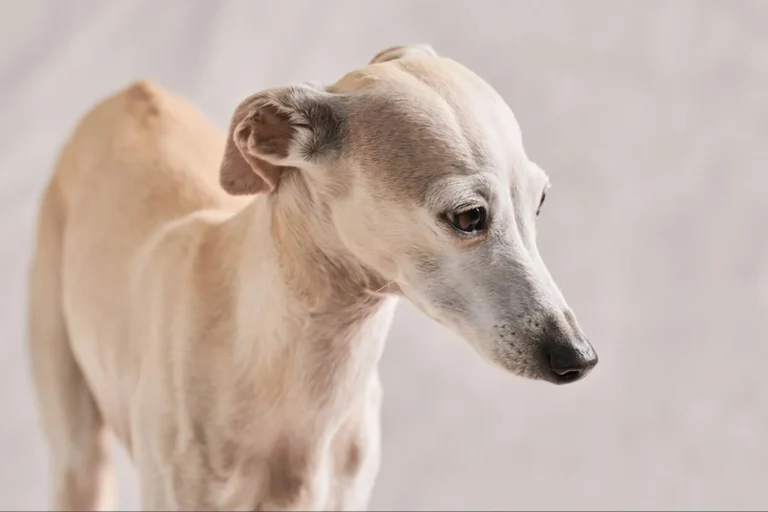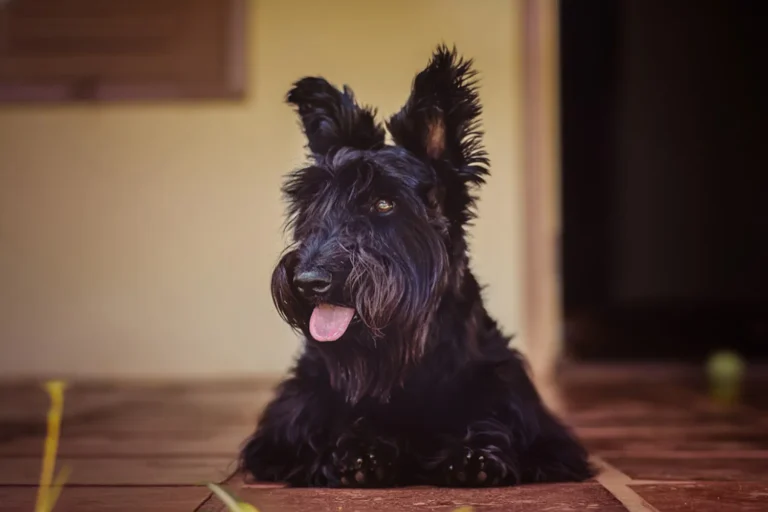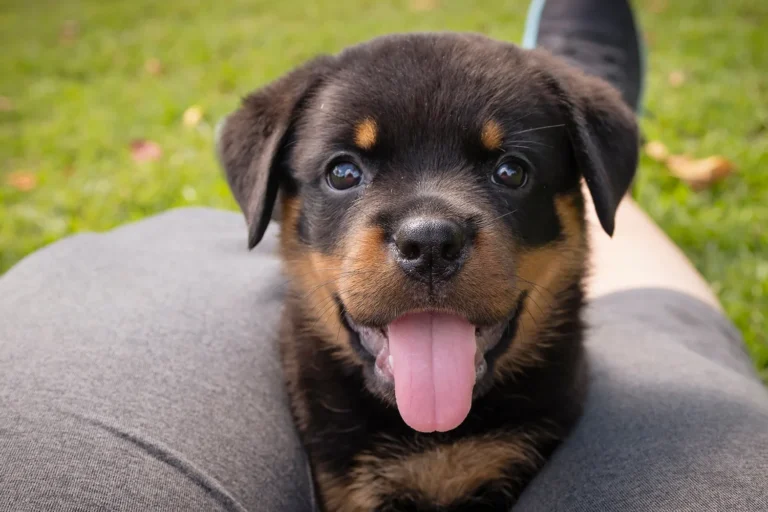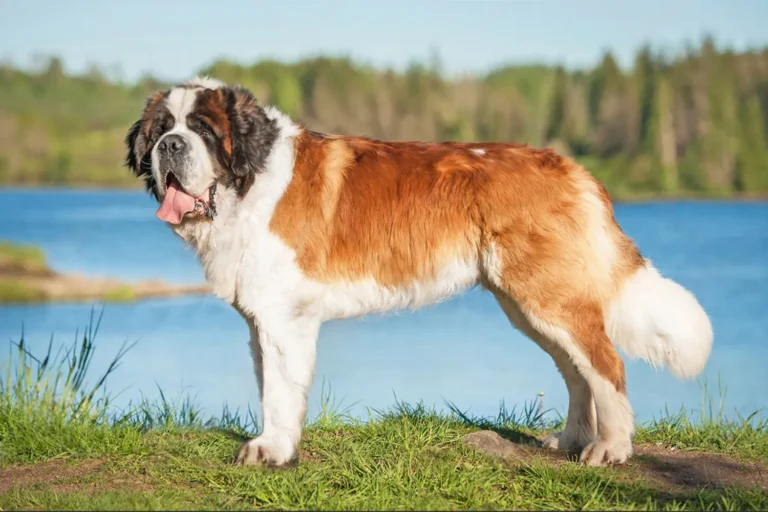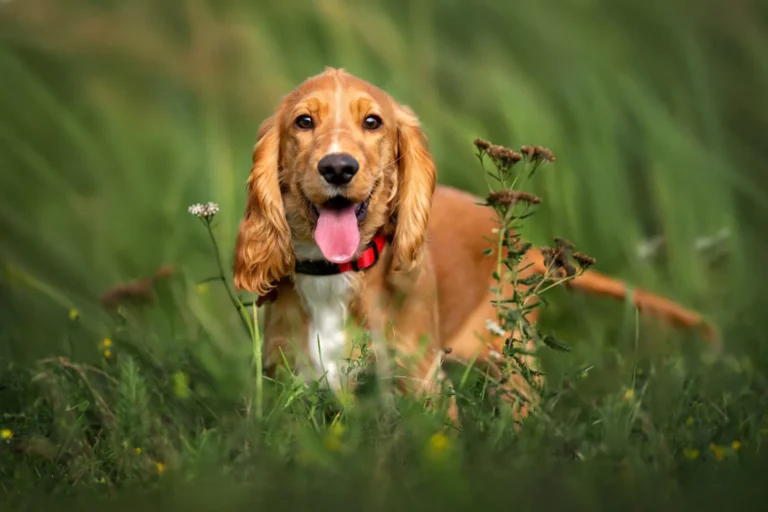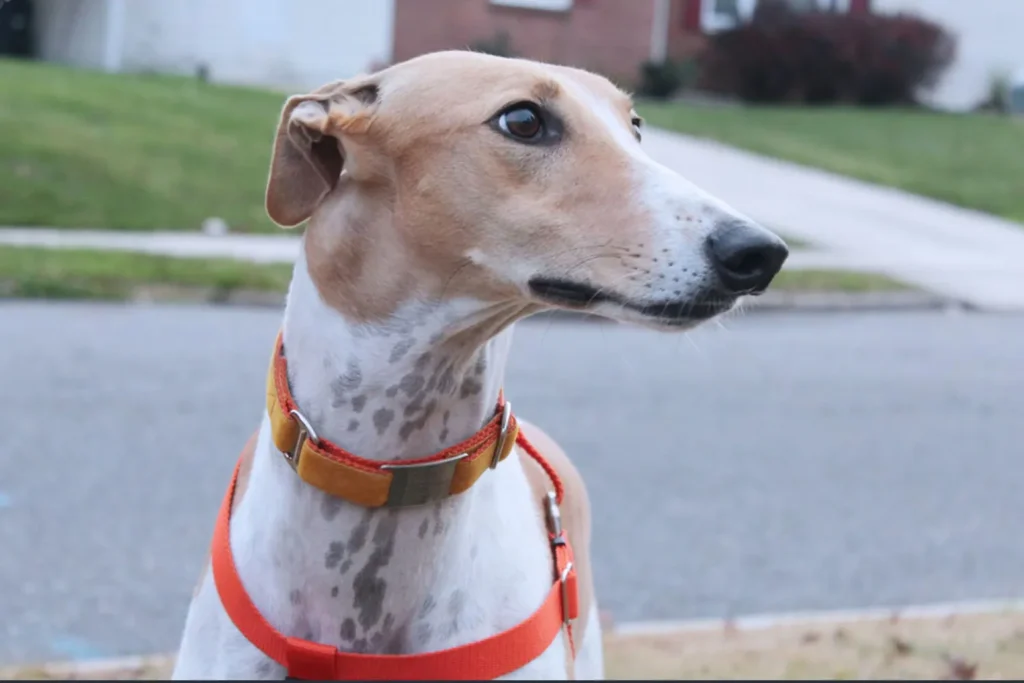
Thinking about bringing a Greyhound into your life? They’re famous for the racetrack, sure, with those sleek bodies and rocket start sprints, but at home they’re often gentle, quiet souls who would happily swap the finish line for a comfy couch. I still laugh about the first retired racer I fostered he did one victory lap around the yard, then discovered the living room sofa and basically declared it his new track. They’re sprinters, not marathoners, so a couple of good walks and a short zoomie session usually does the trick, making them surprisingly well suited to apartments and calm households.
A few real life tips: Greyhounds are sighthounds with a strong prey drive, so keep them leashed outdoors and make sure yards are secure. Their heads are narrow, so a martingale collar or a well fitted harness helps prevent any great escape attempts. With their thin coats and low body fat, they feel the cold mine wore a little coat in winter and appreciated soft bedding year round. They respond best to gentle, confident training and a predictable routine. Grooming is easy light shedding, quick brushing, regular nail trims. If you can, meet a local rescue; retired racers often need a week or two to learn stairs, mirrors, and that yes, the couch is fair game now. Give them patience and a cozy spot, and you’ll get the sweetest, lanky shadow with the best “I’m so comfy” sighs you’ve ever heard.
What is the history and origin of the Greyhound?
Look at a Greyhound and you can almost read its story in that long, aerodynamic silhouette. These dogs trace their roots to the ancient world: murals and carvings from Egypt show slim, fleet footed hounds sprinting across desert scenes, and similar sighthounds were common throughout the Middle East in biblical times. In some English translations, the Bible even mentions a “greyhound,” which always makes me smile imagine a dog so memorable it earned a shout out in scripture. The Romans adored their coursing dogs too, and as they expanded their empire, they brought these swift companions along, seeding the foundations of Greyhound type dogs across Europe.
Over time, Greyhounds became wrapped up with status and ceremony. In parts of medieval Europe they were treated as sacred animals, protected by law and reserved for the elite. There’s a Welsh legend I love telling new Greyhound folks: in the 10th century, King Hywel made killing a Greyhound a capital offense. Dramatic? Yes. But it says a lot about the respect these dogs commanded. You’ll spot their elegant outlines in old tapestries and manuscripts, usually near nobles out hunting or snoozing by a grand hearth, which is very on brand.
Of course, all that reverence had a practical side. Greyhounds were bred for speed and keen eyesight, coursing foxes, hares, and deer across open country. They can hit about 45 miles per hour (72 km/h), using a gorgeous double suspension gallop that turns the ground into a blur. I once watched a fun lure coursing day at a local farm, and the moment the lure zipped off, the Greyhounds became streaks of silver and fawn. Ten seconds later, they were politely asking for biscuits. That’s the Greyhound way: lightning outside, couch ornament inside.
In the 20th century, their athleticism found a new stage with organized racing, and a trip to the dogs became a popular night out. Even if you’ve never been, you’ve probably seen the imagery: the oval track, the mechanical lure, the thunder of paws. What’s changed more recently is how many people have discovered Greyhounds as family pets. Retired racers in particular have introduced countless families to the breed’s gentle, oddly catlike charm. My neighbor adopted a retired racer named Lottie; she learned stairs in a week, claimed the comfiest armchair by day three, and now treats her daily zoomie in the yard like clockwork.
If you’re thinking about welcoming one, a couple of tips from experience: secure fencing is your friend (that prey drive is real), and keep them on leash in unfenced areas. They don’t need marathon walks just regular exercise and a chance to sprint safely. Their coats are thin, so a snug jacket in cold weather makes a big difference. Give them a soft bed, a quiet corner, and some gentle routine, and you’ll have history’s most elegant sprinter dozing happily at your feet proof that a dog can conquer centuries and still end up exactly where it wants to be: on your sofa.
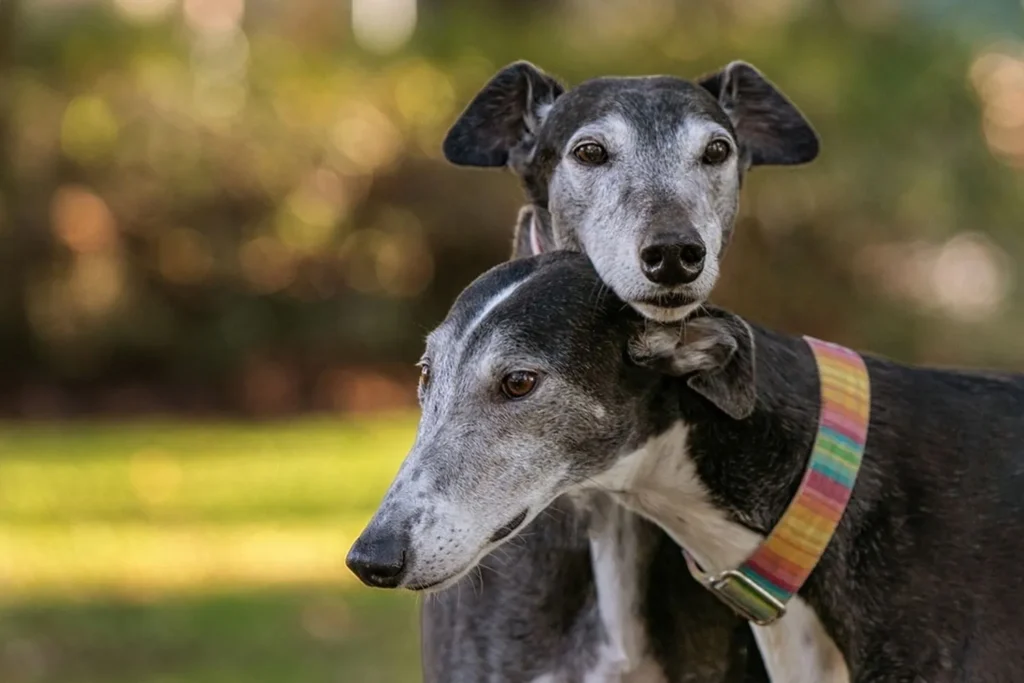
What Is the Greyhound Breed?
The first time I met a Greyhound, I felt like I was watching a living sculpture glide through the room sleek lines, long legs, and that elegant, needle nosed face. They’re famously fast, of course, but what always surprises people is how calm they are at home. After a short burst of energy, most Greyhounds are champion loungers, perfectly content to curl up and nap beside you for hours. They come in beautiful colors like fawn, black, brindle, and white, all equally striking against their slender frames.
Despite that athlete’s build, Greyhounds are gentle souls. They’re friendly and fit in well with families, especially those who appreciate a quiet, affectionate companion. I remember fostering one who would do a goofy five minute zoomie around the yard, then lean into my legs like we were old friends that classic Greyhound “lean” gets me every time. They’re sprinters, not marathoners, so a couple of walks and a chance to run safely now and then usually does the trick.
A few tips from experience: keep them on leash outdoors and use a secure yard squirrels are basically Greyhound TV, and those instincts are real. Their coats are thin, so they love soft beds and might need a snug sweater on chilly mornings. Training goes best with a gentle touch and plenty of praise; they’re sensitive and respond beautifully to kindness. Athletic yet affectionate, a Greyhound is equally happy joining you for a brisk outing or curling up for a cozy evening at home.
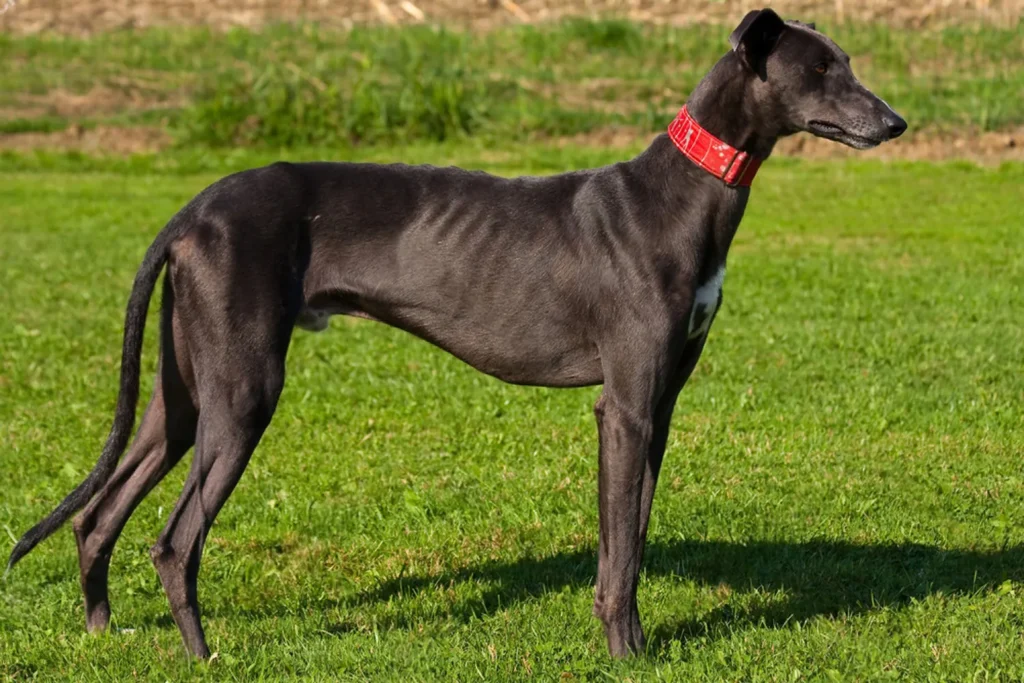
Who is a Greyhound best for?
If you love a calm, elegant companion who’s happy to sprint for a few minutes and then snooze the rest of the day, a Greyhound might be your perfect match. While they’re famous in the racing world, most of the Greyhounds you’ll meet are retired athletes just looking for a cozy couch and a soft hand to lean on. They’re surprisingly well suited to smaller homes and apartments because they’re true sprinters, not marathoners think short bursts of energy followed by championship level napping. I fostered one named Daisy who would zoom around the yard for exactly eight minutes and then curl into a doughnut on her bed for the next several hours.
Most families meet their Greyhound through rescue groups rather than pet stores. In the US, the National Greyhound Adoption Program has been around for years and does a wonderful job guiding retired racers into pet life. A volunteer once told me they’re matchmakers first, runners up second they’ll help you figure out if a dog is cat friendly, kid ready, or better for a quieter home. I went to one of their meet and greets and watched a brindle boy gently lean into a toddler like they’d known each other forever. That famous Greyhound “lean” is real, and it’s their way of saying, “You’re mine.”
A few tips if you’re considering one: plan for daily walks and a safe, fenced area or long line time for a proper sprint now and then. Always use a leash outdoors if something moves fast, their chase instinct can kick in. Their coats are thin and their skin is delicate, so they love cushy beds and a sweater in chilly weather. Many are quiet, polite housemates who rarely bark, and with gentle handling they’re wonderful with respectful kids. If you have cats or small pets, ask the rescue for a dog that’s been tested; many Greyhounds do well, but it’s important to pick the right match.
For someone who can offer a calm home, consistent affection, and a comfy place to nap, a retired Greyhound brings a special kind of sweetness gentle, graceful, and a little bit goofy in the best way.
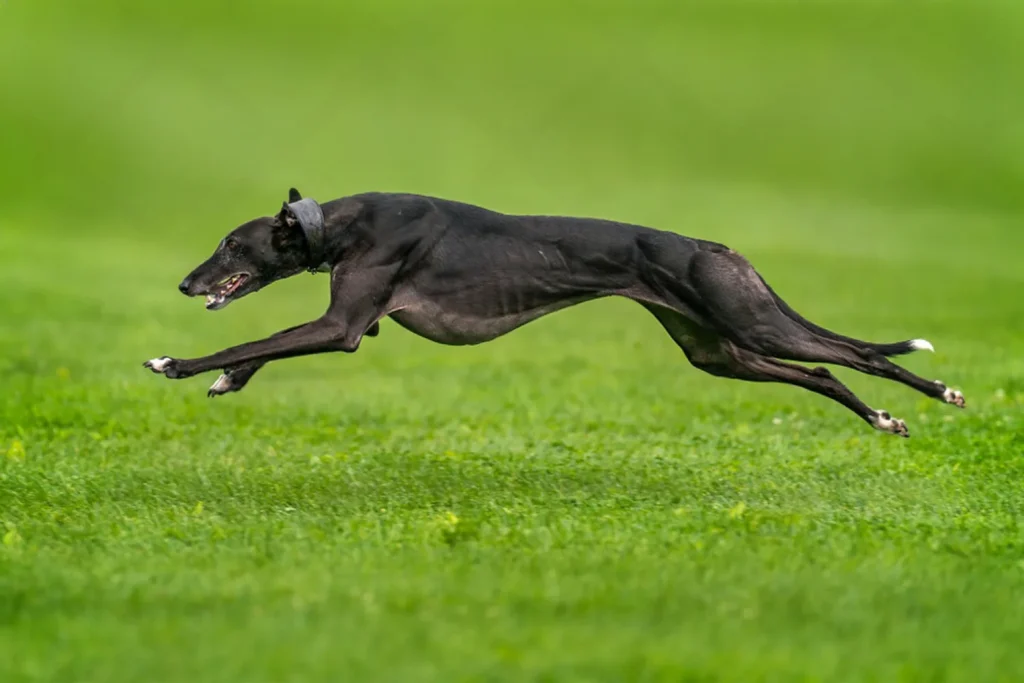
Greyhound Grooming and Shedding
That sleek, aerodynamic coat is wonderfully low maintenance. Most greyhounds are happy with a quick once a week brush to whisk away dust and keep their skin oils distributed. A soft bristle brush works great, and a rubber grooming mitt or curry brush helps grab those short, velvety hairs. I keep a rubber mitt by the sofa five minutes while we watch TV and my friend’s retired racer practically melts into my lap.
They don’t shed as much as many breeds, but you’ll still find fine hairs on blankets and leggings, especially during seasonal changes. A quick pass with the rubber mitt or a damp microfiber cloth lifts loose hair easily, and a lint roller is your best couch buddy. Go gentle greyhounds have thinner skin than some dogs so avoid harsh tools and heavy pressure. Baths can be infrequent (only when they’re dirty), and I like to finish a groom with a nail check and a simple ear wipe. It’s a low fuss routine that keeps them sleek, comfy, and cuddle ready.
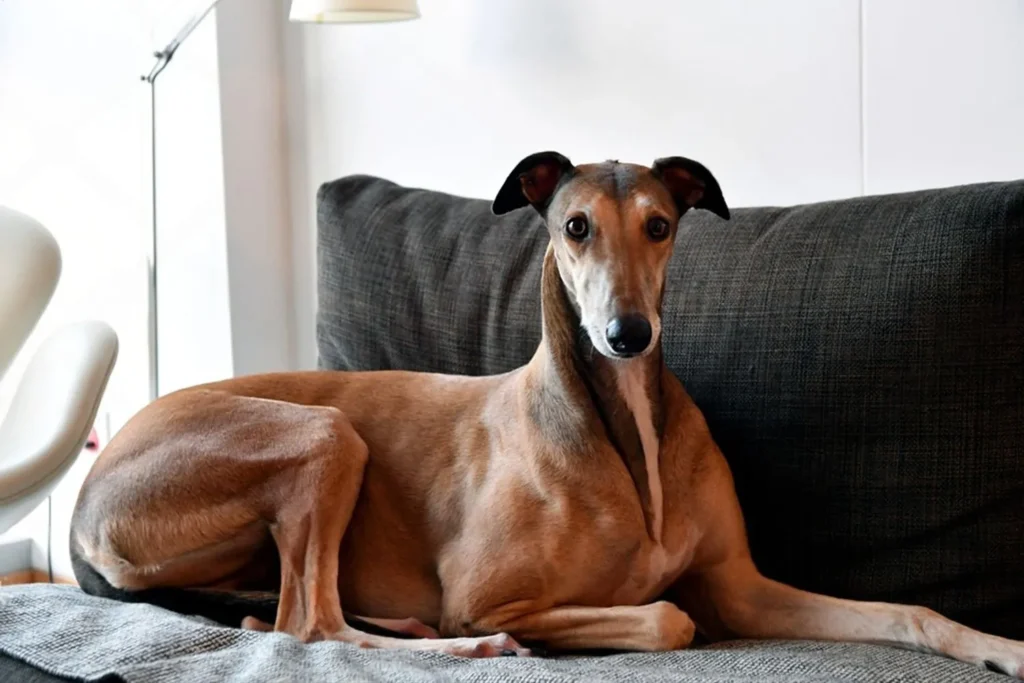
Do Greyhounds Bark a Lot?
In general, Greyhounds are famously quiet. Mine, Willow, could go a whole day without a peep, then offer one polite “woof” if dinner was running late. That said, like most dogs, they’ll find their voice when something stirs big feelings anxiety, a desire for attention, or an exciting dog they spot across the street.
If your Greyhound is barking from nerves, think comfort and routine first. A cozy, predictable space, gentle decompression after walks, and slow introductions to new places or dogs can work wonders. For attention seeking barks, I try to avoid rewarding the noise no eye contact, no chatter then praise and treat the instant they’re quiet. It feels a bit like teaching manners at a dinner table: calm wins the goodies. And when greeting other dogs, give extra space and keep things low key. I once had to loop around the block so Willow could watch a bouncy lab from a distance; five minutes later, we passed calmly with no bark at all.
Most Greyhounds are apartment friendly because of that low volume lifestyle. Just remember to give them mental exercise so boredom doesn’t turn into commentary: sniffy walks, simple puzzle feeders, or a short training session can take the edge off. Teach a “quiet” cue paired with a treat when they pause, and keep your own energy calm. With a little guidance, your Greyhound will likely stay as soft spoken as the breed’s reputation suggests saving those rare barks for moments that truly matter.
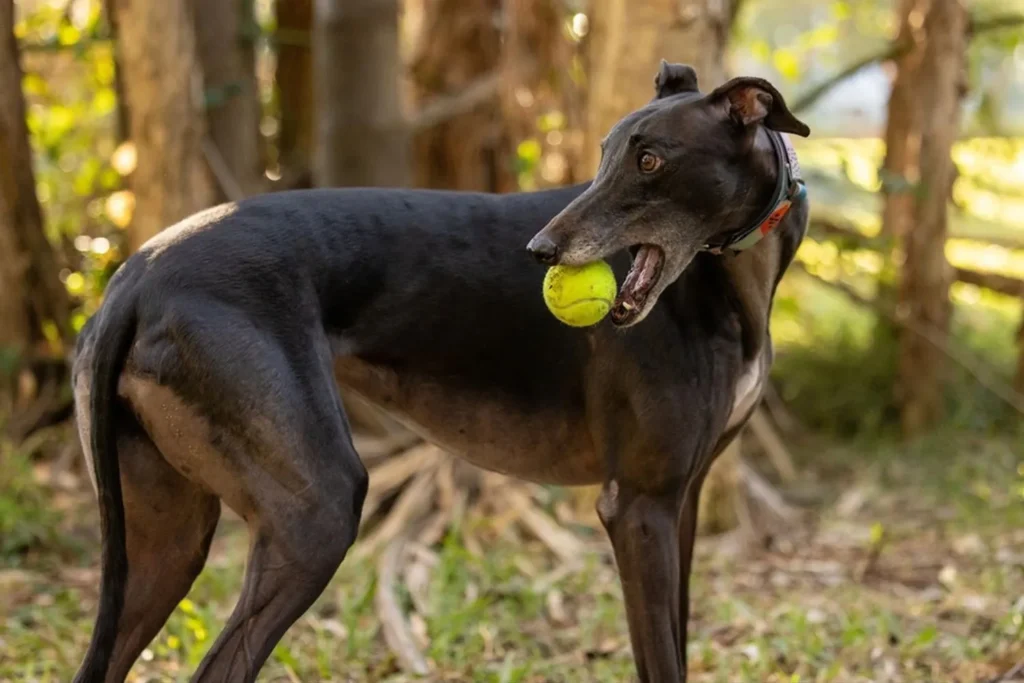
What is the average weight and height of a Greyhound?
Most Greyhounds stand somewhere between 55 cm and 75 cm at the shoulder, with some of the taller sighthound cousins (like the Russian types) often stretching beyond that. As for weight, an adult male Greyhound typically lands around 11 to 16 kg, while females are usually a touch lighter at about 9 to 14 kg. They’re built like sleek athletes light, lean, and made for speed so don’t be surprised if they look more refined than other breeds. I remember taking my first Greyhound to a family picnic and everyone whispering, “Is he eating enough?” He was perfectly healthy just shaped like a living arrow. https://en.wikipedia.org/wiki/Greyhound
If you’re measuring your dog at home, stand them on a flat surface and measure from the ground to the top of the shoulder (the withers). For weight, I’ve done the old “step on the scale with and without the dog” trick when I couldn’t get to the vet, though mine once decided to do a dramatic flop halfway through. A small tip: weigh at the same time of day and before meals if you want consistency. Because Greyhounds are naturally slim, you should be able to feel their ribs under a light layer of muscle, see a defined waist from above, and notice a gentle tummy tuck from the side. That’s usually a good sign they’re right where they should be.
Of course, every Greyhound is an individual. Lineage, activity level, and age all play a part, and some dogs will sit a little taller or heavier than others. My friend’s lanky boy hit the top of that height range but still kept that classic, feather light feel on the leash. If you’re unsure whether your Greyhound is at a healthy size, a quick body condition check with your vet will give you peace of mind and maybe an excuse to share a few racing zoomie stories while you’re there.

Are Greyhounds Easy to Train?
Greyhounds are smart and sensitive, which can make them a joy to train if you play to their strengths. They’re gentle souls who thrive on calm, consistent guidance and plenty of affection. But yes, that famous prey drive is real. Most greyhounds will perk up at the sight of a squirrel or a small, zippy dog, and some will want to give chase. Don’t panic; with the right training and management, you can teach them to keep four paws on the ground and their focus on you.
I remember bringing home an ex racer who thought the neighborhood rabbits were part of a game just for him. We started with easy wins: practicing “watch me” and “leave it” at a distance, on a sturdy leash, with a pocket full of high value treats (think chicken or cheese). A long line in a fenced area was a lifesaver for recall practice. Keep sessions short five to ten minutes and end on a success. Greyhounds don’t love nagging or harsh corrections; a calm voice, gentle guidance, and quick rewards go a long way.
Basic manners matter from day one. Make sure your greyhound responds to familiar cues like “walk,” “no,” and “sit,” and add essentials like “come,” “wait,” and “leave it.” If “sit” is awkward for your dog’s long legs, that’s okay work on a solid “down,” “stand stay,” or “wait” instead. Reward based training is key; let them know when they’ve nailed it. I like to keep a small treat pouch by the door for surprise practice reps on our way outside.
Exercise wise, think routine with a sprinkle of speed. In addition to their running sessions, most greyhounds do well with two walks per day. They love a good sprint in a safe, enclosed space but are otherwise world-class couch potatoes. Mine would zoom for five minutes, then melt into the sofa like warm butter.
A few practical tips from the trenches:
– Use a martingale collar or a well fitted harness greyhounds can slip out of regular collars.
– Keep them on leash unless you’re in a secure area; that prey drive can override even solid training.
– Start socialization slowly, especially around small dogs and cats, and set up calm, controlled introductions.
If you’re new to the breed, training manuals and breed specific classes are fantastic. I once joined a basic manners course with two other sighthounds, and it felt like cheating everyone understood the “squirrel problem.” And if your schedule is hectic, a professional dog walker who knows sighthounds can be a game changer. My friend hired one for midday walks, and her greyhound went from restless to relaxed practically overnight.
Bottom line: greyhounds are very trainable when you lead with patience, positivity, and love. Do that, and you’ll have a graceful running buddy and a snuggly shadow who listens because they trust you.
How Do Greyhounds Behave? A Look at Their Temperament and Personality
Greyhounds are built for speed, not marathons. They love a good burst of running, then they’re ready to flop and sigh dramatically like they’ve conquered the world. I tried taking my friend’s greyhound for a jog once he gave me the most puzzled look, trotted politely for a block, and then practically dragged me toward the nearest fenced field. Short, vigorous sprints in a secure area suit them far better than steady jogging. A fenced yard, an empty tennis court during off hours, or a safe dog run where you can let them zoom for 10-15 minutes is ideal. I like using a flirt pole or a long line for controlled sprints when space is limited. After that, you’ll have a very content dog who’s happy to relax.
Underneath that sleek, athletic exterior, greyhounds can be sensitive souls. Many are naturally shy and may startle if touched suddenly. My first greyhound used to flinch when I reached over his head, so I learned to move slowly, speak before I touch, and pet under the chin first. Gentle, steady socialization makes a world of difference: short car rides, calm visits to friends’ homes, quiet strolls downtown, and brief, positive introductions to other dogs. Keep early experiences low key and sweeten them with treats. I ask visitors to toss a treat on the floor before saying hello it lets a shy greyhound approach on their own terms.
Most greyhounds are lovely with children, but supervision and clear rules are nonnegotiable. Teach kids not to grab, climb, or take anything from the dog especially food. Resource guarding can pop up if a child reaches for a bowl or tasty chew. I feed in a separate corner and tell little ones, “When the dog is eating or on their bed, we give space.” It’s simple, and it prevents grumbles and misunderstandings.
Don’t be surprised by how much they enjoy resting. After a proper sprint, greyhounds settle in like seasoned nappers: long stretches on a cushy bed, sunbathing by the window, or curling into a donut after dinner. They’re not lazy about exercise they just prefer their workouts short and intense, followed by a lot of peace and quiet. Give them a predictable routine, a safe place to run, and a soft spot to snooze, and you’ll uncover their sweet, gentle personality in no time.
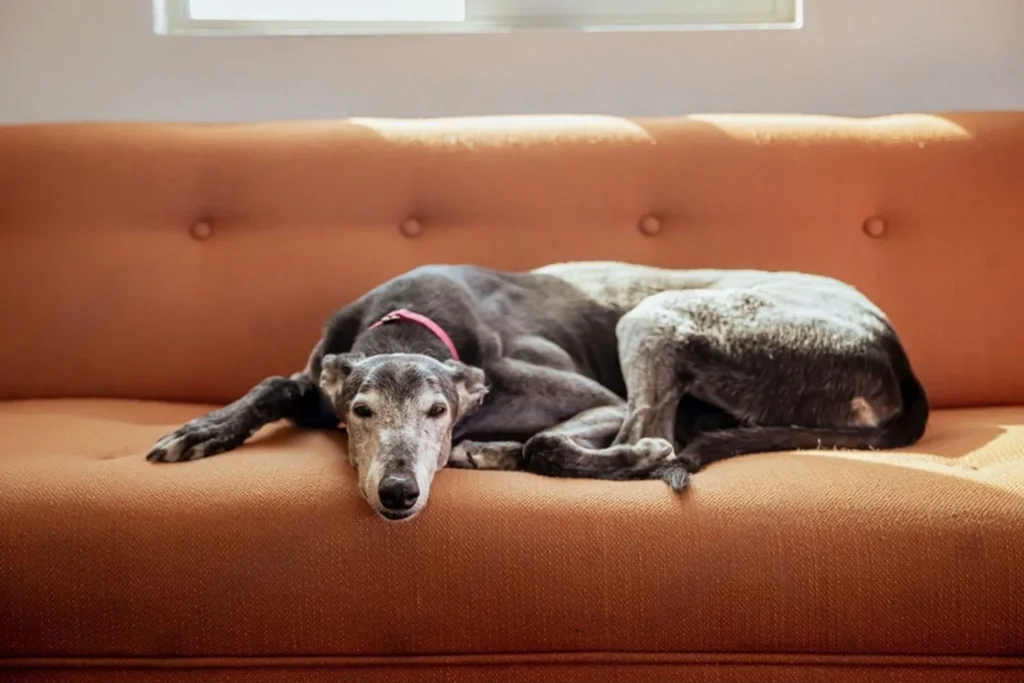
Do Greyhounds Have Common Health Issues?
Greyhounds are surprisingly sturdy for such elegant, slender dogs, but they do come with a few quirks you’ll want to know about. First things first: don’t leave a greyhound outside for long stretches, especially in cold weather. With so little body fat and such thin skin, they chill fast. Mine practically shivers if a breeze looks at him the wrong way. A cozy coat, soft bed, and short winter potty breaks make a world of difference.
Overall, greyhounds are healthy dogs, just a bit more predisposed to certain problems than some other breeds. I’ve seen more allergy flare ups with greyhounds than with most dogs think itchy skin, paw licking, or ear issues. Regular baths with a gentle shampoo and wiping paws after walks helped my friend’s greyhound stop the springtime itch. Dental health is another biggie. A lot of greyhound vet visits are for teeth and gums, so start brushing early, offer safe dental chews, and don’t skip professional cleanings if your vet recommends them. It’s amazing how much better their breath gets your couch will thank you.
Because they’re built for speed and have long, delicate legs, greyhounds can be prone to musculoskeletal injuries. I always warm mine up with a short leash walk before letting him sprint, and I keep zoomies on grass instead of slick surfaces. Non slip rugs inside are a must. Retired racers, especially, may carry old strains that show up after adoption, so go slow and build fitness gradually.
You might also hear that greyhounds can have heart differences and a slightly higher risk of certain cancers. That’s true, and it’s one reason I like working with a vet who understands sighthounds. Regular checkups catch subtle changes early. On the medication front, greyhounds can be sensitive to certain drugs and anesthesia. I keep a note in my phone and always mention it at appointments so dosages are tailored to the breed.
Here are some of the most common health issues to keep on your radar:
– Gastric Dilatation and Volvulus (Bloat): A life threatening emergency where the stomach twists. Learn the signs restlessness, a tight swollen belly, unproductive retching and get to a vet immediately. I feed smaller meals and avoid hard play right before and after eating to lower the risk.
– Musculoskeletal Injuries: Fractures, sprains, and strains can happen with all that speed. Warm up, cool down, keep nails short, and stick to safe running surfaces.
– Polyneuropathy: A nerve issue that can cause weakness and coordination problems. If your greyhound seems wobbly, knuckles their paws, or tires unusually fast, call your vet for a neurological check.
– Drug Sensitivity: Greyhounds may react differently to some medications and anesthetics. Use a vet familiar with sighthounds and ask about adjusted protocols.
– Bone Cancer (Osteosarcoma): More common in greyhounds than in some breeds. Watch for persistent lameness, swelling on a limb, or pain that doesn’t match a minor bump, and see your vet promptly.
One last tip from experience: keep your emergency clinic’s number on the fridge and in your phone. A neighbor once recognized early signs of bloat in her greyhound and that quick call made all the difference. With a bit of breed savvy care warm coats, gentle exercise, good dental habits, and regular vet visits greyhounds thrive. And then you get what we all secretly want: a sprinting athlete who turns into a 40-mile per hour couch ornament by 8 p.m.
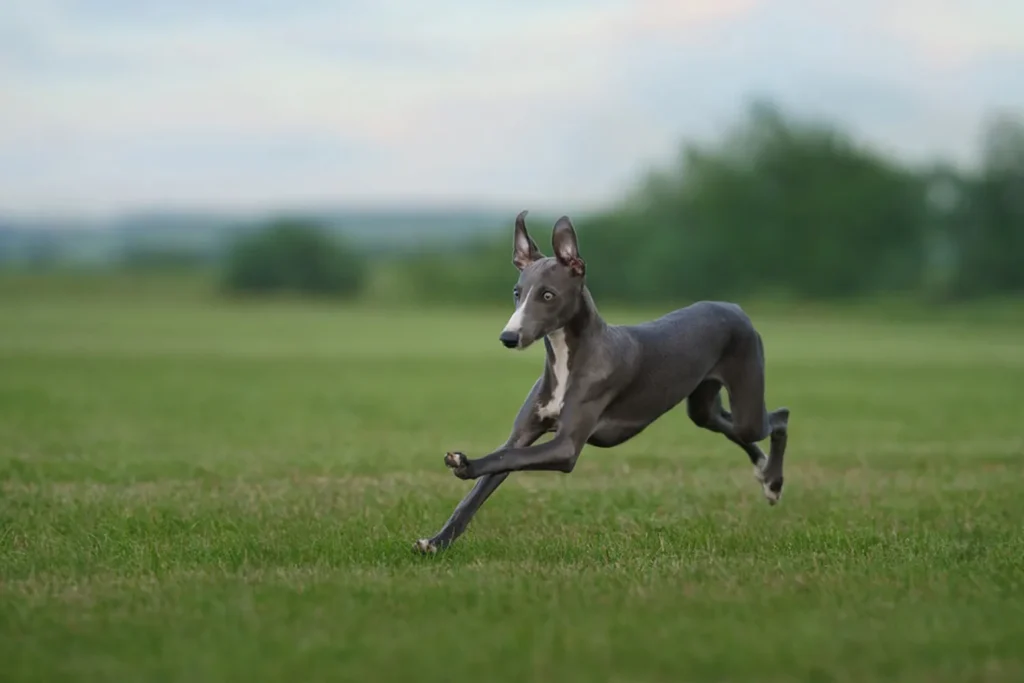
What Is the Lifespan of a Greyhound?
Greyhounds are surprisingly sturdy dogs, and many stay spry well into their senior years. Most live about 10 to 15 years, which is a lovely, long stretch for such tall, athletic pups. Because many racers retire around five years old (some even younger), they’ve got a lot of life left when they settle into a couch of their own. I’ll never forget bringing home my retired racer at four he went from track star to blanket burrito in about a week.
The key to those happy, long years is thoughtful, everyday care. Keep them lean with a balanced diet and regular, low impact exercise daily walks with a few joyful zoomies are perfect. Greyhounds have thin coats and bony elbows, so a soft bed (or three) makes a big difference, and a cozy sweater helps on chilly mornings. I learned quickly that short nails and good dental care are not optional with this breed; a monthly nail trim and a few minutes of brushing teeth can save a lot of trouble later. Yearly vet checkups, plus a chat about joint health as they age, are well worth it.
Don’t forget their minds, either. Snuffle mats, gentle training games, and a quiet puzzle toy can tire them out in the best way. With a little consistency and a lot of love, Greyhounds glide through their golden years with grace still ready for a silly sprint, then right back to the sofa.
How Much Should a Greyhound Eat?
Most Greyhounds do beautifully on two meals a day. A simple routine of a good meat portion (around 500 grams) paired with kibble (about two cups) is enough for most dogs to keep their energy up and their figures sleek. When I brought my first retired racer home, I found that breakfast and dinner at set times helped his tummy settle and made it easy to measure portions. I like to keep an eye on the waistline and ribs slight tuck and easy to feel ribs mean we’re in the right zone. If your hound is more couch potato than sprinter, you might trim the amounts a bit; if you’ve got a zoomie machine, you may nudge them up.
Because Greyhounds can be prone to dental issues, sheep brisket is a great choice of meat it does a little “toothbrush” work while they chew. I used to offer a meaty brisket bone under supervision a couple of times a week, and it made a real difference to breath and tartar. As always, never feed cooked bones, and check with your vet about what’s safe for your dog. A quick brush a few evenings a week helps, too; my hound eventually learned to tolerate the chicken flavored toothpaste bribe.
Don’t forget water. They need plenty of clean, fresh water around seven cups a day, and more in hot weather or after a good romp. I like to refresh bowls often and sometimes add a splash to meals for dogs that tend to gulp. Avoid strenuous exercise for about an hour before and after meals to keep sensitive tummies happy. If you’re switching foods, do it gradually over a week, and remember that training treats count subtract a little from the next meal to keep everything in balance. If in doubt, your vet can help tailor the portions to your Greyhound’s age, weight, and activity level.
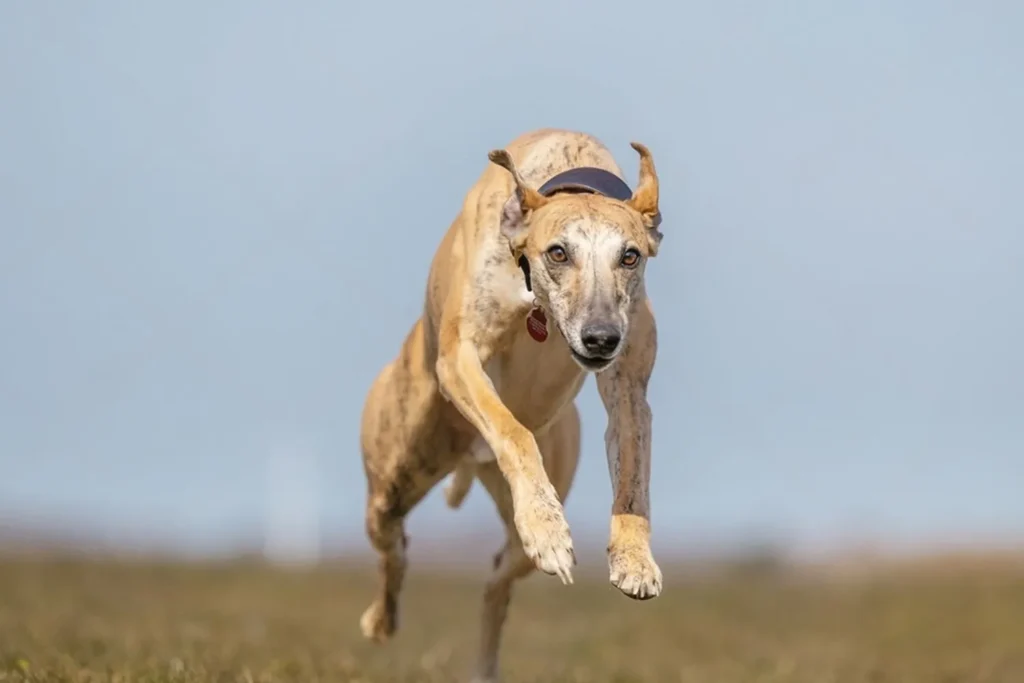
Greyhound FAQs
Do adult Greyhounds get on well with other animals, including other dogs?
Greyhounds are famously gentle souls. They’re sensitive, soft hearted, and generally not the type to go looking for a scuffle with other pets. Many Greyhound folks I know live happily with a mix of breeds little terriers, big goofy retrievers and report a peaceful household. Mine would rather sidestep drama and find the comfiest bed in the room.
That said, first meetings can be noisy. A bark or a grumble when they encounter a new dog isn’t unusual in the dog world, and Greyhounds are no exception. I like to do calm, on leash introductions and then a short “parallel walk” so everyone gets used to each other without the pressure of face to face greetings. If you’re introducing a Greyhound to smaller pets, go slowly and supervise, especially in the beginning. Even the most tender hearted dog can get excited around fast, fluttery movement. Set them up for success with gates, safe zones, and short, positive sessions.
Where can I find responsible breeders of Greyhound puppies?
Start with reputable organizations. In the United States, the American Kennel Club is a solid resource, and equivalents in other countries like the Kennel Club in the UK and the National Kennel Council in Australia can point you toward breeders who follow strict codes of practice. These groups can also help verify pedigree claims, which is one less thing to stress over.
When you connect with a breeder, expect lots of questions good breeders want to make great matches. Ask to meet the dam or sire if possible, see where puppies are raised, and request health information and contracts. I like breeders who offer lifetime support and are happy to talk through temperament, socialization, and what to expect as your puppy grows. And if you’re open to it, don’t forget that many people also welcome retired racers into their homes; your local Greyhound rescue can be a wonderful resource.
Are Greyhounds more intelligent than other dog breeds?
They’re about average in raw “obedience class” smarts, but that’s only part of the picture. Greyhounds shine in instinct and experience. They’re observant, quick to learn routines, and quietly excellent problem solvers. Mine learned the sound of the treat jar from three rooms away and figured out how to nudge the back door just enough to sunbathe on the step.
Training goes best with kindness and a sense of humor. Keep sessions short, use tasty rewards, and don’t take a stubborn pause personally sighthounds can be independent thinkers. Puzzle toys and scent games are great for a Greyhound’s brain on rainy days.
As racing dogs, do I need to be physically active to keep up with a Greyhound?
You don’t need to be a sprinter. Greyhounds can hit an incredible 45 mph (72 km/h), and it’s a joy to watch them stretch their legs, but they’re sprinters, not marathoners. Most are happy with a couple of good walks and a few zoomies, then they’re back to champion couch status. I time our “flights” in a secure, fenced area or use a long line in open spaces, and then we mosey home for naps.
Safety tip: always let them run in safe, enclosed places and away from roads. A well fitted harness, solid recall practice, and a bit of common sense go a long way. On hot or very cold days, keep sessions short Greyhounds have thin coats and appreciate a jacket in chilly weather. After a quick burst of speed and some sniffing, they’re usually content to curl up beside you and snore like a tiny lawnmower.
Disclaimer:
This article is for informational purposes only and doesn’t replace professional veterinary or training advice. Always consult a certified vet or dog trainer for guidance specific to your pup.
